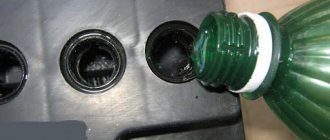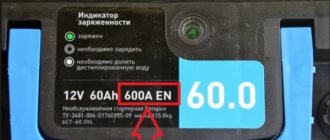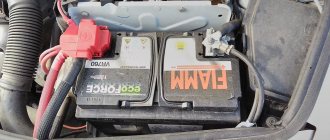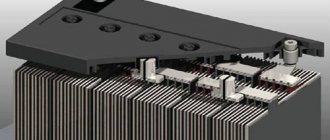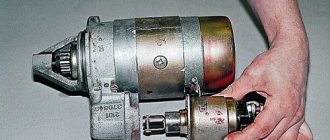One of the main elements in a battery is the electrolyte. It stores energy for operation; without this fluid, the battery will cease to function. Based on the state of the electrolyte, you can determine the degree of wear of the battery. When there are no faults, the solution is clean, with a neutral tint. If, when charging the battery, the electrolyte becomes cloudy or changes, it means that the battery is faulty to one degree or another. Let's consider the reasons for the cloudiness of this liquid and how to solve the problem.
The electrolyte becomes cloudy when the battery is faulty.
Why does the battery fluid darken?
Battery electrolyte is a mixture of distilled water and concentrated sulfuric acid. The initial color of both liquids is transparent, and it remains so after mixing. Being inside a working power source, the solution does not change its natural color and continues to remain transparent.
Reference. If you look into a working serviceable battery through one of the open plugs, you can see lead plates - a clean electrolyte allows this to be done.
When the sulfuric acid solution becomes cloudy or turns black, there is a battery malfunction due to a violation of the structure of the plates. Unfortunately, the vast majority of car enthusiasts pay attention to the color of the liquid after the manifestation of more tangible signs - unexpected battery discharge, boiling over, and so on.
If the electrolyte in the battery has become cloudy or blackened, the following reasons should be considered:
- the lead filler has begun to shed from the plates, at an early stage the liquid becomes cloudy and then turns black;
- Dirt has gotten inside the power source being serviced, causing a cloudy sediment to appear;
- the car owner accidentally added ordinary water, low-quality distillate or electrolyte of unknown origin to the cans;
- battery overheating;
- the plates received excessive charging voltage over a long period (called overcharging).
Dirt in the battery is a fairly rare cause of darkening of the solution. It takes a lot of effort to introduce foreign particles into the electrolytic liquid. On maintenance-free products, dirt ingress is virtually eliminated.
Cloudiness due to adding the wrong solution, overheating or overcharging is much more common. In the first case, a chemical reaction provokes the precipitation of foreign inclusions, which floats in the electrolyte and creates turbidity. Overheating can occur due to a malfunction of the car alternator and voltage regulator, as well as when charging the battery with a powerful homemade device.
Reference. The maximum permissible temperature of the electrolytic fluid during battery operation is 40 °C. When heated above the specified value, the solution begins to lose its chemical properties and becomes cloudy.
Bad advice
The Internet is full of advisors who give ridiculous solutions to problems, and there are several myths floating around. Under no circumstances should you adhere to them, because such advice can kill the battery.
Here are some of them:
- Use snow instead of distillate. Snow is not distilled water. Adding it to the electrolyte causes breakdown.
- If lead precipitation occurs, pour out the electrolyte, rinse the jar with water and fill with a new substance. This was practiced in the last century. Modern battery banks have tightly spaced electrodes on which separator bags are stretched. It is impossible to pump out liquid with lead sediment from such jars. The pieces will not pass through the electrodes.
- Some sites sell so-called modifiers. According to the manufacturers, the products easily clean the electrolyte and extend the life of the battery. But these devices are the same as technologies that reduce fuel consumption. They do not work.
Consequences of cloudiness
If the sulfuric acid battery solution changes color and the car owner does not take proper measures to correct the problem, the following consequences will occur:
- Black electrolyte is a clear sign of destruction of the plates; the darkening is caused by crumbling lead. In this case, the battery cannot be restored - the battery will have to be replaced.
- A cloudy electrolyte is the result of foreign impurities or the initial stage of lead shedding. The destructive process can be stopped by replacing the working fluid and eliminating the source of the problem.
Blackening of the solution occurs both in one section of the power source and in all banks at the same time. The result is the same: the chemical reaction on the crumbled plates is significantly weakened and the battery capacity is reduced. In addition, floating lead particles cause a short circuit between the plates, quickly rendering the battery unusable.
Before changing the dark electrolyte, find the cause of the cloudy fluid and eliminate it. The solution loses transparency due to the following problems:
- The terminals receive a voltage that exceeds the norm - 15 volts. The battery heats up, the water from the solution boils away, and the top of the jar is exposed. The problem probably lies in the generator or electronic charging voltage regulator.
- Freezing of the power supply. If a discharged battery is stored in the cold, the density of the electrolyte decreases and the proportion of water in the solution freezes. Ice can destroy not only cans, but also the body of the product.
- The liquid becomes cloudy after a deep discharge. For example, you left your car in a garage for several days with the headlights on. There is a chance of recovery, but the battery will have to be charged for a long time at low currents.
Replacing cloudy fluid
First of all, try to get rid of the turbidity in the simplest way - charge the battery with an automatic device with the function of plate desulfation and periodic shutdown. If the voltage at the terminals has not dropped below 12.7 V, and the destruction process has not yet begun, recharging can help and return the solution to transparency.
It is most likely useless to change the black electrolyte in the battery. For the sake of personal peace of mind, it is worth making such an attempt, but one point must be taken into account: half-crumbling plates will never accept a charge in the required quantity. The battery capacity will remain low.
What to do with cloudy electrolyte if charging does not produce results:
- Clean the outside of the battery case to prevent dirt from getting inside the working sections.
- Empty the power source by unscrewing the caps of all cans. In a maintenance-free product, you need to remove the built-in hydrometer (otherwise known as a peephole, an indicator of serviceability) by prying it by the edges with two screwdrivers.
- Thoroughly rinse the inside of the battery with distilled water. Try to rinse as much sediment as possible from the cans and drain the washing liquid.
- Buy a new electrolyte in the store with a density of 1.31–1.34 g/cm 3 and prepare a working fluid, bringing the density to 1.27–1.29 g/cm 3 by adding a small amount of distillate.
- Pour the electrolytic solution into the battery section and charge it with a current of 2 A, periodically measuring the voltage. At the time of measurement, the automatic charger must be disconnected from the power supply.
In most cases, the described procedure helps to get rid of cloudiness, provided that in the future the battery is used correctly and the electrical equipment of the machine is in good condition.
Better washing with the removal of various impurities is performed with a chemical solution of ammonia and a substance called Trilon B. For 1 liter of distillate, 50 ml of ammonia and 20 ml of Trilon are added, after which the solution is slowly poured into the battery. When the reaction is complete, the liquid is drained, rinsed again with distilled water and the jars filled with fresh electrolyte.
After charging, do not forget to check the density of the solution and its level . The liquid should completely cover the plates of each section, and the density should remain at the level of 1.27–1.29 g/cm3. If after a few hours the indicator changes downwards (without connecting a load), the battery will have to be replaced.
The electrolyte is a mixture of sulfuric acid solution and distilled water. This component is one of the most important components involved in the operation of a car battery.
In a well-functioning battery, the electrolyte should be transparent, without any impurities. That is why it is very important to use only clean chemical components and equipment when preparing it.
Simple Troubleshooting
If you can determine that the battery is discharged, then in this case it is enough to connect the battery to the power supply and wait a while. As the charge is received, the liquid will restore its color.
When sulfating platinum, it is necessary to perform more complex manipulations. First you need to rub the battery a little. After that:
- Add a small amount of distilled water to the battery to bring the electrolyte level to normal.
- We connect the battery to the charger (it is recommended to set it for eight hours).
If during charging the electrolyte temperature exceeds 43 degrees, then it must either be kept at this level or reduced slightly. However, at this stage it is important to ensure that the voltage in one of the battery jars does not drop to a level below average (up to 0.2 V). If this happens, you must immediately stop the procedure and take the battery for repair or replace it.
Things are much worse if the electrolyte in one or several battery containers has not only lost its transparency, but has completely turned black. In this case, the problem is explained by the fact that the so-called coating of the plates (essentially lead oxide) of the battery has crumbled or the device was operated in a discharged state.
Reasons why the electrolyte is cloudy
In some cases, the transparent electrolyte begins to take on a cloudy tint. Why does this happen and how can you eliminate the problems associated with it?
The electrolyte may become cloudy for the following reasons:
- Dirt getting into the battery. This is the most common cause of darkening of the mixture;
- Adding water with foreign impurities. Sometimes the water may contain high levels of chlorine or iron, which will affect the appearance of the solution;
- Use of low-quality electrolyte. Most often, this problem occurs when you independently add a low-quality solution;
- Recharging the battery. In this case, a color change may occur due to the penetration of parts of the grease from the electrodes into the electrolyte. The main reason for overcharging is a faulty generator, as well as charging with low-quality chargers, poor operation of the relay - the “pill” regulator, or constant use of the battery, since in this mode it does not have time to cool;
- Temperature increase. This problem is relevant in the summer, since in extreme heat the electrolyte can become very hot. A temperature of more than 35-37 degrees is considered catastrophic for it, at which the processes leading to wear of the electrodes are most strongly activated;
- Replacing distilled water with tap water. Tap water contains impurities and metals, which cause the electrodes to fail faster;
- Constantly discharged battery. For this reason, the density of the substance decreases, it changes appearance, and the energy characteristics of the battery are greatly reduced;
- Defrosting the battery. This problem is typical in winter, when after severe freezing, the monoblock bursts during the defrosting process of the battery. Very often, after thawing, the electrolyte begins to leak out.
How to return the transparent color to the electrolyte?
After identifying the cause, you can try to return the substance to its original color, thereby extending the life of the battery. In some cases, restoration of operation is impossible and you will have to buy a new battery.
First you need to determine what color the solution has acquired. If the solution has a gray or brown tint, the battery must be recharged. As a rule, this color has an electrolyte, which contains undissolved sulfate crystals, which, when properly charged, completely dissolve and the color becomes transparent again.
A dark shade turning into black usually indicates that almost all the coatings from the plates have fallen off and got into the solution. In this case, the battery must be replaced.
If the electrolyte has lost a little transparency, but has generally retained its color, it is necessary to let the battery stand without charging. Then excess impurities will settle to the bottom and transparency will be restored. Typically, such a procedure only temporarily prevents battery replacement, since destructive processes in the solution have already begun.
Conclusion
The moral is that if the solution is cloudy or gray in all jars, then the battery is treated. To do this, use the tips described above. However, if one jar turns black, then most likely you will have to buy a new battery.
If a breakdown is detected, it is advisable to contact an experienced technician who can correctly diagnose and solve the problem.
The health of the battery can be judged not only by the voltage level at its terminals, but also by the color of the electrolyte in the jars. Of course, such diagnostics can only be performed if you have a serviceable battery model. If you are the happy owner of such a battery, then if a problem is detected in a timely manner, you will save the battery.
Replacing cloudy electrolyte in a battery
Sometimes cloudy electrolyte can be changed to restore the functionality of an old battery. To do this you need:
- Drain the old electrolyte;
- Clean the battery from dust and dirt using distilled water;
- Make sure that after washing the battery case is absolutely clean and there are no carbon chips left inside;
- Clean the electrodes from deposits and salts;
- Check the density of the newly filled electrolyte. The density should be 1.28 g/s³ m;
- Pour the solution through the funnel;
- Make sure that all the air is out of the battery case;
- Wait until all additives dissolve. Typically it takes 2 days;
- Charge the battery. It should be charged in cycles, charging and discharging the battery. The current should be supplied in the region of 0.1 ampere.
During the last action, the density should be monitored. The process is considered complete if the density remains within normal limits for 2 hours.
Thus, having identified the reason why the electrolyte has become cloudy, normal operation of the battery can be resumed or extended, and sometimes, a new one can be purchased.

